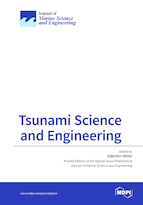Tsunami Science and Engineering
A special issue of Journal of Marine Science and Engineering (ISSN 2077-1312).
Deadline for manuscript submissions: closed (30 June 2015) | Viewed by 91415
Special Issue Editor
Interests: coastal engineering; computational fluid dynamics; experimental fluid dynamics; fuid-structure interaction; granular slides; hydraulic structures; landslide-tsunamis; scale effects; similarity
Special Issues, Collections and Topics in MDPI journals
Special Issue Information
Dear Colleagues,
Recent earthquake-tsunamis including the 2004 Indian Ocean Tsunami, with over 230,000 casualties, and the 2011 Tōhoku Tsunami in Japan, with over 18,500 people missing or dead, serve as tragic reminders that such waves pose a major natural hazard to human beings. Landslide-tsunamis, including the 1958 Lituya Bay case, may exceed 150 m in height and if similar waves are generated in lakes or reservoirs (so-called impulse waves), then they may overtop dams and cause significant devastation downstream, such as in the 1963 Vaiont case with around 2,000 casualties.
The after-effects due to such catastrophes are not limited to the region immediately impacted by the wave; for example, the 1963 Vaiont case affected hydropower plant planning and management globally and the 2011 Tōhoku Tsunami initiated changes to nuclear power plant policies worldwide.
Active prevention of the wave generation is extremely unlikely and limited to rare cases where creeping slides could be stabilized. Scientists and engineers thus work mainly on passive methods to face this hazard. In many cases, the propagation time between generation and shoreline is sufficiently long, allowing early warning systems for evacuation to be an effective passive method. For impulse waves in smaller water bodies, however, the propagation time is too short for an adequate evacuation so further passive methods are critical. Such methods include sea walls, reinforced infrastructure and the provision of adequate freeboards of dam reservoirs. These methods require detailed knowledge of (i) the wave features as a function of the generation mechanism, (ii) the shoreline run-up and (iii) the interaction with structures.
Despite a significant increase in research activities after the 2004 Indian Ocean Tsunami, there certainly can be — and needs to be — more research with the aim to reduce the destruction caused by tsunamis to us and our environment.
This special issue “Tsunami Science and Engineering” is launched to reflect our current understanding of tsunamis and tsunami mitigation, irrespective of the mechanism by which they are generated: earthquakes, landslides, underwater slumps, asteroids etc. Welcome are research papers, reviews (state of the art) and case studies addressing tsunamis and/or impulse waves theoretically, experimentally, numerically and/or based on field studies. I sincerely look forward to receiving original and exciting contributions of high quality.
Dr. Valentin Heller
Guest Editor
Manuscript Submission Information
Manuscripts should be submitted online at www.mdpi.com by registering and logging in to this website. Once you are registered, click here to go to the submission form. Manuscripts can be submitted until the deadline. All submissions that pass pre-check are peer-reviewed. Accepted papers will be published continuously in the journal (as soon as accepted) and will be listed together on the special issue website. Research articles, review articles as well as short communications are invited. For planned papers, a title and short abstract (about 100 words) can be sent to the Editorial Office for announcement on this website.
Submitted manuscripts should not have been published previously, nor be under consideration for publication elsewhere (except conference proceedings papers). All manuscripts are thoroughly refereed through a single-blind peer-review process. A guide for authors and other relevant information for submission of manuscripts is available on the Instructions for Authors page. Journal of Marine Science and Engineering is an international peer-reviewed open access monthly journal published by MDPI.
Please visit the Instructions for Authors page before submitting a manuscript. The Article Processing Charge (APC) for publication in this open access journal is 2600 CHF (Swiss Francs). Submitted papers should be well formatted and use good English. Authors may use MDPI's English editing service prior to publication or during author revisions.
Keywords
- Earthquake-tsunamis
- Impulse waves
- Landslide-generated impulse waves
- Landslide-tsunamis
- Long wave run-up
- Seismic tsunamis
- Solitary waves
- Tsunami early warning system
- Tsunami forecasting
- Tsunami hazard assessment
- Tsunami hazard mitigation
- Tsunami-induced overland flow
- Tsunami loading on structures






